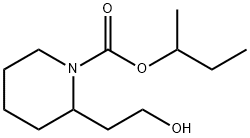sec-Butyl2-(2-hydroxyethyl)piperidine-1-carboxylate , 98% , 119515-38-7
CAS NO.:119515-38-7
Empirical Formula: C12H23NO3
Molecular Weight: 229.32
MDL number: MFCD01756488
EINECS: 423-210-8
| Pack Size | Price | Stock | Quantity |
| 1g | RMB24.00 | In Stock |
|
| 5g | RMB29.60 | In Stock |
|
| 10g | RMB44.00 | In Stock |
|
| 25g | RMB84.80 | In Stock |
|
| 100g | RMB275.20 | In Stock |
|
| 500g | RMB896.00 | In Stock |
|
| others | Enquire |
PRODUCT Properties
| Melting point: | <-170° |
| Boiling point: | 2800C |
| Density | d20 1.07 |
| refractive index | nD20 1.4717 |
| Flash point: | 142°C |
| storage temp. | Sealed in dry,2-8°C |
| solubility | Chloroform (Slightly), Methanol (Slightly) |
| form | Oil |
| pka | 15.15±0.10(Predicted) |
| color | Colourless |
| CAS DataBase Reference | 119515-38-7 |
| EPA Substance Registry System | Icaridin (119515-38-7) |
Description and Uses
Picaridin is an insect repellent. It inhibits A. aegypti odorant receptor 2 (AaOR2) or AaOR8 in the presence of their odorant activators, indole and octenol, respectively, expressed in Xenopus oocytes (IC50s = 1,452 and 1,911 μM, respectively). Picaridin reduces the number of entries into a food chamber by female D. melanogaster in an olfactory-based choice assay. It acts synergistically with the non-pyrethroid insecticide pyrimiphos methyl to increase mortality of A. gambiae and reduce blood feeding when used at a concentration of 10 g/m2 on nets surrounding guinea pig cages. Formulations containing picaridin have been used as insect repellents against flies, mosquitoes, chiggers, ticks, and fleas.
Insect repellent.
Safety
| Symbol(GHS) |   GHS02,GHS07 |
| Signal word | Danger |
| Hazard statements | H225-H315-H319-H335 |
| Precautionary statements | P261-P305+P351+P338 |
| Hazardous Substances Data | 119515-38-7(Hazardous Substances Data) |
| Toxicity | LD50 in rats (mg/kg): 4743 orally; >2000 dermally (Yap); LC50 in rainbow trout (96 hr): 173 mg/l; in bobwhite quail (5 day diet): >5000 ppm a.i. in diet (WHO). |



